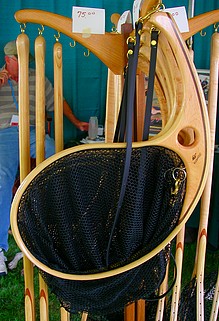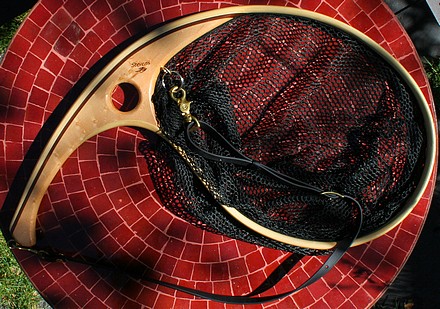I love rural Maine, and one of the reasons is the tradition of craftsmanship; they build stuff rather than buy it, and the state's history of "sporting craftsmanship" is strong indeed.
That's why I wasn't surprised when I found some killer craftsman at Grand Lake's crafts festival, including a talented wooden net maker whose work impressed the hell out of me.

Stevens Nets builds a hell of a wooden net right here in the USA.
Located in Anson, Maine (near the Kennebec River), Stevens Nets is the brainchild of Alan Stevens, a retired math teacher and canoe builder who started building nets for his own use. His nets are beautiful, and at a time when industry heavyweight Brodin has moved production offshore, I was impressed with his prices.

Stevens builds a full range of nets (Stevens Net photo) from tiny to large.
Stevens builds a whole line of nets, but what caught my eye was this oddly curved net. A left-handed landing net??

A curved landing net? Huh?
Nope. Once again, the Trout Underground comes up clueless. It's a stripping basket you wear around your waist (your hip fits against inside of the frame near the cutout circle).
I didn't believe it at first, but Alan Stevens gave me a quick demonstration, right down to the potential uses of the cutout (it's there for production purposes, but it happens to be exactly the right size for a shot glass).

It hasn't been fishing yet, but I'll let you know when it has.
Stripping baskets are commonly used in saltwater (and I've got a folding model for that), but I think a stripping basket might be handy when streamer fishing. Will it work?
Who knows, but I'm a sucker for handcrafted things, especially when I can trade jokes with the craftsman (thank god I didn't have $3400 with me or I'd have bought a Fiddlehead canoe, but more on that in an upcoming post).
Stevens builds nets with the new lightweight rubber bags (in addition to the nylon bag shown), and right now they're doing the summer fair circuit, so availability isn't great. Still, if you're interested in a hand-made, USA-built net, visit the Stevens Nets Web site. Tell 'em the Trout Underground sent you.

Shot glass holder? It is now...
I've got a couple more short posts coming from the Maine file (you lucky bastards), so stay tuned.
fly fishing, fishing, maine, landing net, fishing net, wooden fishing net, stevens net